Best Croatia’s Cycling Routes and Bike Tours
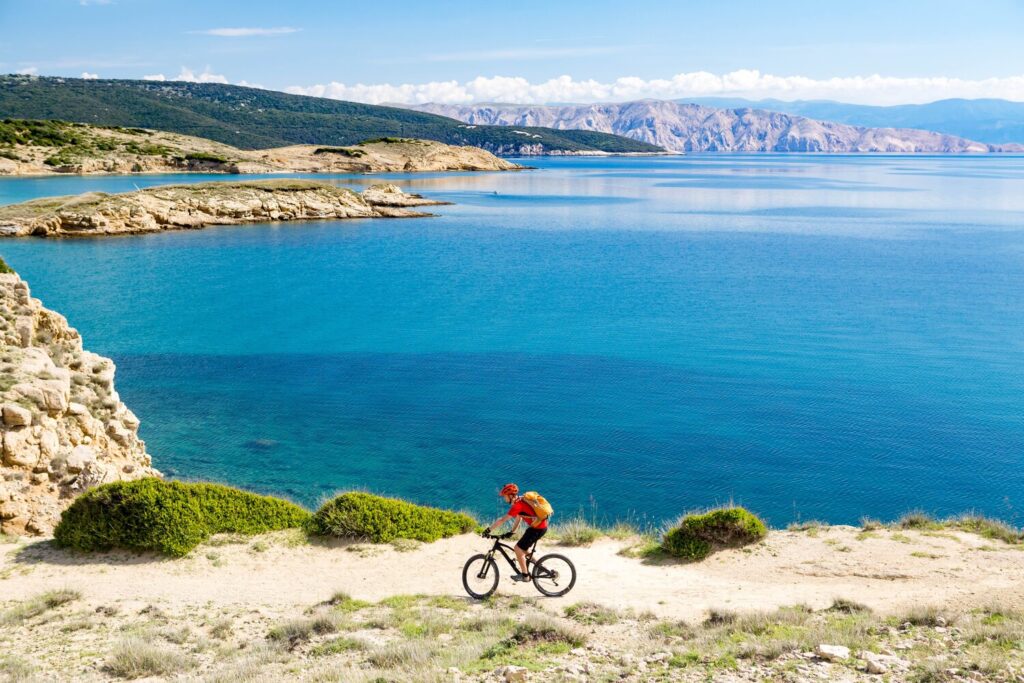
Croatia offers a wealth of natural beauty, rich history, and diverse landscapes, making it a cyclist paradise. From scenic coastal roads to picturesque islands and charming medieval towns to stunning national parks, Croatia provides a wide range of cycling routes and bike tours that cater to all levels of riders. Whether you’re an avid cyclist seeking a challenging adventure or a leisurely rider looking to soak in the beauty of the Croatian coast or countryside, this article will guide you through some of the best cycling routes and bike tours Croatia has to offer.
Cycling Croatia Coast
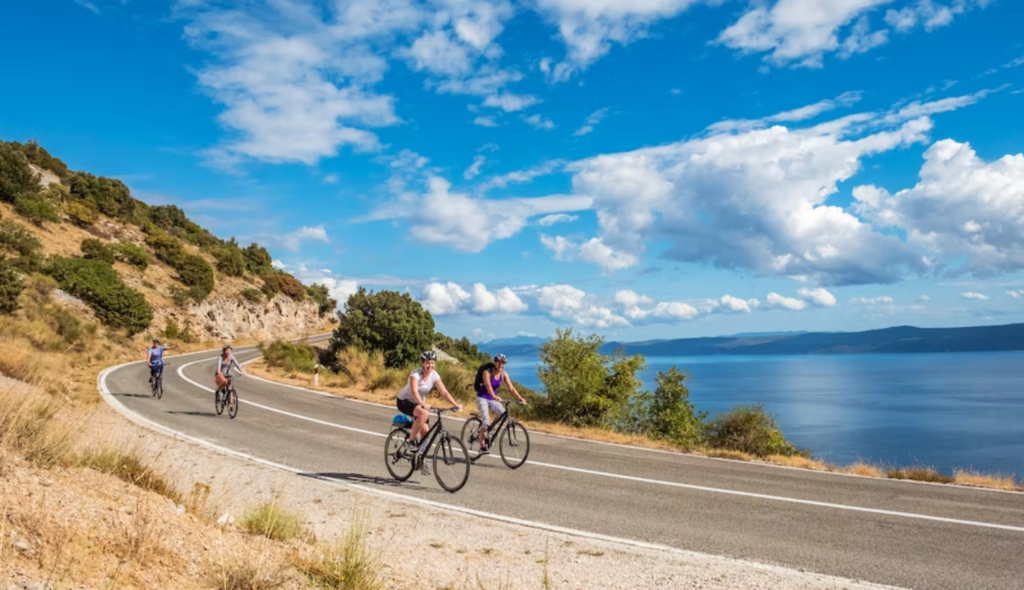
Cycling along the picturesque Croatian coast is an experience that transports you to a world of breathtaking natural beauty, charming coastal towns, and rich cultural heritage.
The Adriatic Sea glistens as a sparkling companion, its azure waters creating a stunning backdrop for the adventure that awaits.
As you pedal along the well-maintained coastal paths, you’ll be treated to mesmerizing views of rugged cliffs, hidden coves, and lush Mediterranean vegetation.
Each twist and turn reveals a new postcard-perfect scene, enticing you to slow down and soak in the beauty surrounding you.
EuroVelo 8 Cycling Route
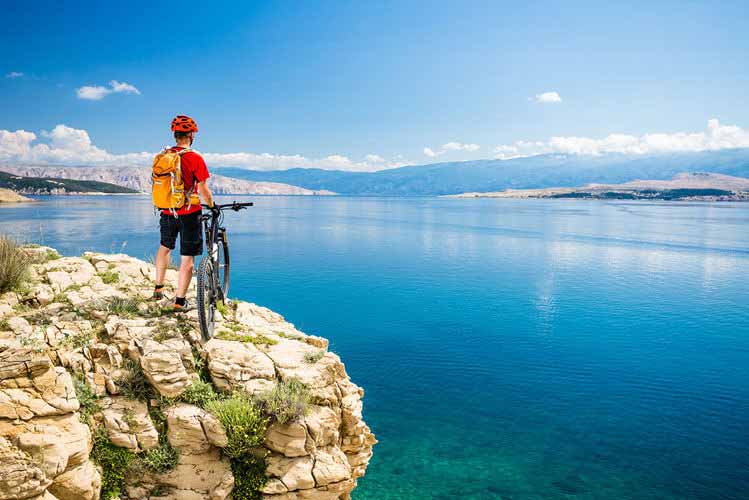
Croatia actively participates in the EuroVelo network, which encompasses a vast array of cycling routes connecting every corner of the European continent.
With a total of 17 diverse cycling routes traversing across 42 countries in Europe, these paths span over an impressive 90,000 planned kilometers, offering tourists a unique opportunity to explore a multitude of European destinations through multi-day journeys.
Additionally, locals frequently utilize these routes for their daily biking and cycling activities.
Croatia finds itself situated along four of the EuroVelo international cycling routes, including the renowned
- EuroVelo 6 route, also known as the Danube Route or the Atlantic Ocean – Black Sea route,
- the EuroVelo 8 route, famously referred to as the Mediterranean Route,
- the EuroVelo 9 route, commonly known as the Baltic – Adriatic Sea route, and lastly,
- the EuroVelo 13 route, also recognized as the Iron Curtain Trail.
EuroVelo 8, also known as the Mediterranean Route, is a section of the European cycle network traverses ten countries along the Mediterranean Sea.
In Croatia, the route covers approximately 500 kilometers, starting from the Slovenian border in Istria and extending down to the southernmost city of Dubrovnik.
Embarking on EuroVelo 8 in Croatia, cyclists are treated to a stunning coastal panorama. The route winds through Istria, Croatia’s largest peninsula, where charming medieval towns like Poreč, Rovinj, and Pula dot the landscape.
These towns captivate with their cobblestone streets, ancient Roman ruins, and vibrant waterfronts. Cyclists can explore the Brijuni Islands National Park, a hidden gem of exceptional natural beauty.
Continuing south, the route unveils the Kvarner Gulf, where Opatija lures visitors with its Belle Époque architecture and a delightful promenade.
Further along the route, the city of Zadar beckons with its enchanting old town and the mesmerizing Sea Organ and Sun Salutation installations.
Next on your journey is Šibenik, home to the impressive St. James’ Cathedral, a UNESCO World Heritage site.
This architectural masterpiece, constructed entirely of stone, showcases intricate details and remarkable craftsmanship.
After exploring the cathedral, stroll through Šibenik’s charming old town, with its labyrinthine streets and cozy cafes.
As EuroVelo 8 hugs the Dalmatian Coast, cyclists encounter some of Croatia’s most captivating destinations. With its iconic Diocletian’s Palace, Split uniquely blends ancient history and vibrant modern life.
The route then weaves its way through the dramatic landscapes of the Makarska Riviera, with its towering cliffs and idyllic beaches.
Further south, cyclists reach Dubrovnik, the “Pearl of the Adriatic.” Enclosed by medieval walls, this UNESCO World Heritage Site exudes charm at every corner, inviting visitors to explore its rich history and soak up its Mediterranean ambiance.
A journey along EuroVelo 8 in Croatia is not just about breathtaking scenery; it’s also an opportunity to indulge in the country’s delectable cuisine and exquisite wines. Istria, known as the “Tuscany of Croatia,” boasts truffles, olive oil, and succulent seafood.
In Dalmatia, cyclists can savor traditional dishes like peka (slow-cooked meat or fish) and sample renowned local wines in the vineyards of the Pelješac Peninsula.
To ensure a comfortable and enjoyable cycling experience, Croatia offers a range of accommodations and services along the EuroVelo 8 route.
Cyclists can find a variety of hotels, guesthouses, and campsites that cater specifically to their needs.
Additionally, major towns and cities offer bike rental services, repair shops, and tourist information centers.
Istria: Exploring the Gem of the Adriatic on Two Wheels
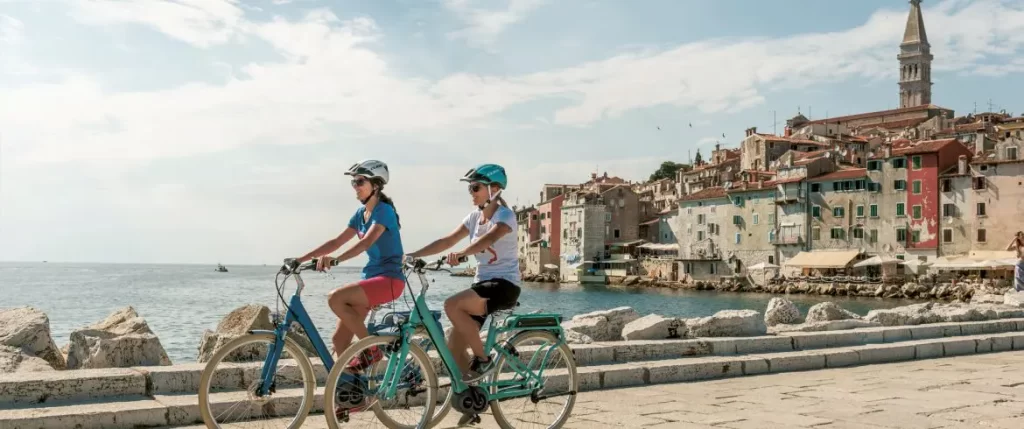
Istria, a renowned region, is a dream destination for cyclists. Its rolling hills, charming hilltop villages, vineyards, and olive groves make it an ideal region to explore on a bike.
Istria boasts a comprehensive cycling infrastructure, providing a wide range of routes suitable for cyclists of all skill levels.
From leisurely coastal paths to challenging mountain trails, something suits every preference.
Here are a few standout routes that highlight the best of Istria’s diverse landscapes:
- Parenzana Trail: Following the path of an old railway line, this iconic route stretches for 78 kilometers, linking the towns of Buje and Poreč. Meandering through rolling hills, vineyards, and quaint villages, cyclists can soak in the region’s rural charm while enjoying panoramic views of the Adriatic Sea.
- Cape Kamenjak Circuit: Located in the southernmost part of Istria, Cape Kamenjak is a nature reserve renowned for its pristine coastline and untouched beauty. The circular cycling route around the cape covers approximately 30 kilometers, offering breathtaking vistas of rugged cliffs, hidden coves, and crystal-clear waters.
- Lim Channel Route: Starting from Rovinj, this route takes cyclists along the picturesque Lim Channel, a fjord-like channel known for its lush vegetation and aquaculture. As you pedal through olive groves and vineyards, be sure to take a break and sample the region’s famous Istrian olive oil and wines.
Main tourist attractions and towns:
- Pula: As the largest city in Istria, Pula is a perfect starting point for your cycling adventure. The city is renowned for its well-preserved Roman amphitheater, the Pula Arena, which dates back to the 1st century AD. Explore the city’s old town, visit the Temple of Augustus, and soak up the vibrant atmosphere of its bustling marketplaces.
- Rovinj: With its narrow cobbled streets, colorful facades, and picturesque harbor, Rovinj is a must-visit. Climb up to the St. Euphemia Church for panoramic views of the town and dine in Michelin-stared restaurants or enjoy fresh seafood at the local restaurants. Rovinj is also a great base for exploring the surrounding islands and beaches.
- Motovun: Perched atop a hill, Motovun is a medieval town famous for its well-preserved city walls and truffle festivals. Explore the winding streets, visit the Motovun Forest to search for truffles, and indulge in local delicacies at traditional konoba (taverns). The view from the top of the town offers a spectacular panorama of the Istrian countryside.
- Grožnjan: Known as the “Town of Artists,” Grožnjan is a haven for art lovers and musicians. This charming hilltop town is dotted with galleries, studios, and jazz cafés. Stroll through the narrow streets, admire the colorful murals, and immerse yourself in the creative atmosphere of this cultural gem.
- Brijuni National Park: Located on the Brijuni Islands, this national park is a true natural paradise. Take a boat from Fažana and explore the islands by bike, encountering exotic flora, ancient ruins, and the former summer residence of Josip Broz Tito, the former president of Yugoslavia.
Dubrovnik and the Adriatic Coast: Cycling through History
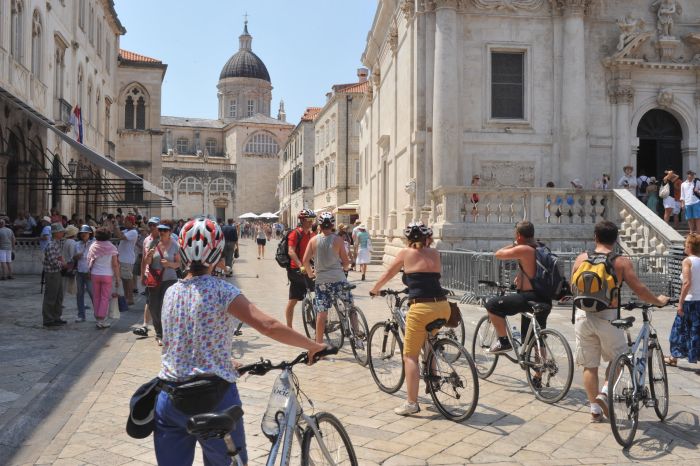
Dubrovnik, often referred to as the “Pearl of the Adriatic,” is a city steeped in history and charm. A bike tour along the Adriatic Coast from Split to Dubrovnik takes you through picturesque coastal places like Ston and Makarska Riviera.
You’ll have the opportunity to pedal along the famous Dubrovnik city walls, visit ancient Roman ruins, and enjoy the stunning vistas of the Adriatic Sea. This routes perfectly blends culture, history, and natural beauty.
Let’s journey through the most captivating cycling routes this enchanting city offers:
- The Dubrovnik City Walls Loop: Begin your cycling adventure by visiting Dubrovnik’s iconic city walls. These ancient fortifications span approximately two kilometers and offer an unparalleled glimpse into the city’s rich past. Cycling along the walls provides a unique perspective, allowing you to witness the stunning juxtaposition of the red rooftops against the azure Adriatic Sea. As you pedal, make sure to stop at various viewpoints to capture the perfect photograph or soak in the breathtaking panoramas.
- The Dubrovnik Riviera Coastal Ride: The Dubrovnik Riviera offers a delightful coastal route for those seeking a more relaxed cycling experience. Begin in Dubrovnik and pedal along the scenic Adriatic coastline, passing charming villages, hidden coves, and sandy beaches. Take your time to stop for a refreshing swim in the crystal-clear waters or enjoy a seaside picnic. Along the way, you’ll encounter historical sites such as the 16th-century Arboretum Trsteno and the picturesque village of Zaton, where you can savor fresh seafood at waterfront restaurants.
- The Konavle Valley Trail: Escape the hustle and bustle of the city and venture into the picturesque Konavle Valley. Located just a short distance from Dubrovnik, this verdant region is a cyclist’s paradise. The route takes you through quaint villages, vineyards, and olive groves, offering an authentic glimpse into the rural life of Croatia. Immerse yourself in the rich cultural heritage as you pedal past traditional stone houses, charming chapels, and historic watermills. Don’t forget to sample local delicacies such as smoked ham and regional wines at the village taverns.
- The Elaphiti Islands Expedition: For a truly memorable cycling experience, sail to the nearby Elaphiti Islands and explore their hidden treasures on two wheels. Take a ferry from Dubrovnik and choose between Koločep, Lopud, and Šipan islands, each with its unique charm. Once you arrive, pedal along coastal paths, passing through fragrant pine forests, sandy beaches, and quaint fishing villages. Indulge in refreshing swims in secluded coves and relish the tranquility of these car-free islands. Be sure to visit the historical landmarks, such as the 15th-century Suđurađ Castle on Šipan, as you delve into the islands’ rich history.
- The Ston and Pelješac Peninsula Route: If you’re up for a challenge and seeking a more rigorous cycling experience, head northwest of Dubrovnik to the Pelješac Peninsula. This route takes you through rugged landscapes, vineyards, and charming seaside villages. Start your journey in Ston, known for its impressive defensive walls and delicious oysters. From there, pedal along the coast, enjoying the panoramic views of the Adriatic Sea, before reaching the village of Orebić.
- Korčula Island Tour: Take a short ferry ride to the island of Korčula, the birthplace of the famous explorer Marco Polo. Explore its narrow streets and medieval architecture before returning to the mainland.
While cycling in Dubrovnik, it is important to adhere to local traffic rules, wear appropriate safety gear, and respect the environment. Consider renting a bike from one of the many rental shops in the city, or join a guided cycling tour to fully immerse yourself in the experience.
Krka National Park Cycling Routes: Waterfalls and Serenity
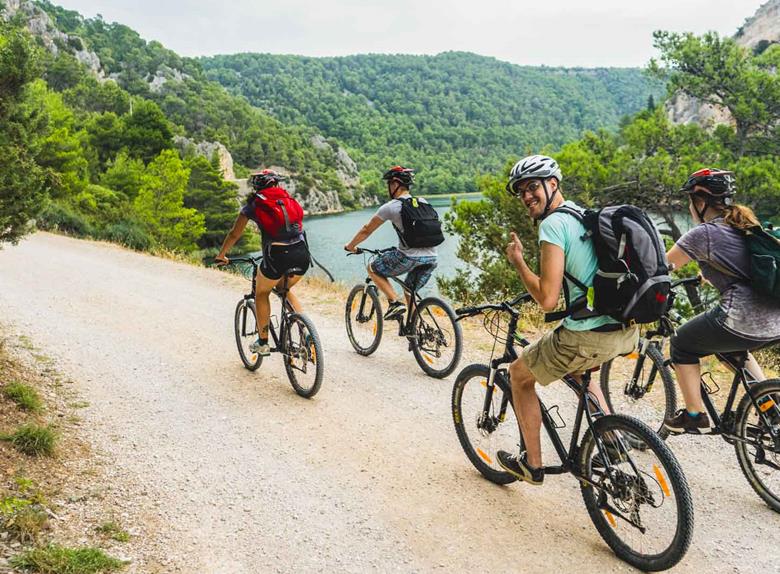
Located in central Dalmatia, Krka National Park is renowned for its magnificent waterfalls and emerald-green river.
Exploring this natural wonder on a bike allows you to enjoy the park’s tranquility while admiring its cascades and lush landscapes.
The park offers cycling paths that wind through forests and meadows, leading you to hidden viewpoints and swimming spots where you can take a refreshing dip in the crystal-clear waters.
Explore the captivating Krka National Park and uncover an extensive network of bike routes spanning an impressive distance of 388 kilometers.
Amidst the sanctuary of protected nature and enriched by its exceptional cultural and historical legacy, these bike routes have been meticulously crafted as circular paths, ensuring that cyclists can return to their starting point without retracing their steps.
While occasional intersections and parallel stretches occur along the paths, it is not intended for cyclists to switch between routes.
To embark on these captivating cycling adventures, there are three distinct starting and finishing points to choose from:
- the Krka National Park Office in Skradin,
- the Visitor Centre at Laškovica, and
- the Krka Eco Campus at Puljane.
Offering a diverse array of options, the twelve available cycling routes consist of three Mountain Bike (MTB) routes, three Road routes, and six Track routes that cater to delightful family outings.
The routes are clearly marked with appropriate biking-touristic signage, ensuring a seamless navigation experience for visitors.
Additionally, detailed brochures featuring comprehensive descriptions, captivating photographs, maps, and GPS coordinates of each route are readily accessible on Krka National Park’s official website, providing visitors with all the essential information they need to embark on their cycling journey through this mesmerizing national park.
Discover more bike routes from various travel and adventure agencies, and plan your next cycling adventure ahead.
Cycling Croatian Islands
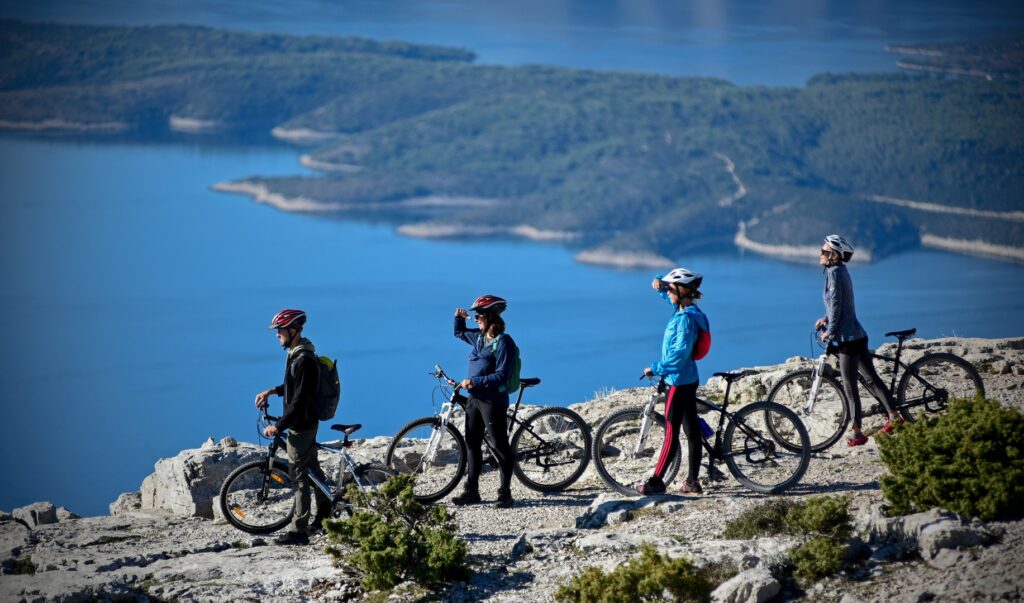
The Dalmatian Islands, scattered along the Croatian coast, offer an unparalleled island-hopping experience for cyclists.
Starting from Split or Dubrovnik, you can embark on a bike tour that takes you through a series of islands like Hvar, Brač, Vis, and Korčula.
Take a ferry to Brač from Split, known for its picturesque beaches and the famous Zlatni Rat (Golden Horn).
From there, head to Hvar, and discover its ancient ruins and vineyards, lavender fields, vand vibrant nightlife.
Further south, the island of Korčula awaits, inviting you to discover its rich history and idyllic vineyards.
End your island escapade in Dubrovnik, exploring its ancient city walls and immersing yourself in the Game of Thrones filming locations.
Each island has its unique charm, with beautiful beaches, ancient towns, and scenic coastal roads. The relatively flat terrain of the islands, coupled with stunning vistas at every turn, makes cycling a delight in this part of Croatia.
As we continue our exploration, we set our sights on the stunning Dalmatian Islands.
These gems of the Adriatic Sea offer a cycling experience like no other. Start your island-hopping adventure in Split, the gateway to the islands.
The UNESCO 704 Cycling Route on Hvar Island
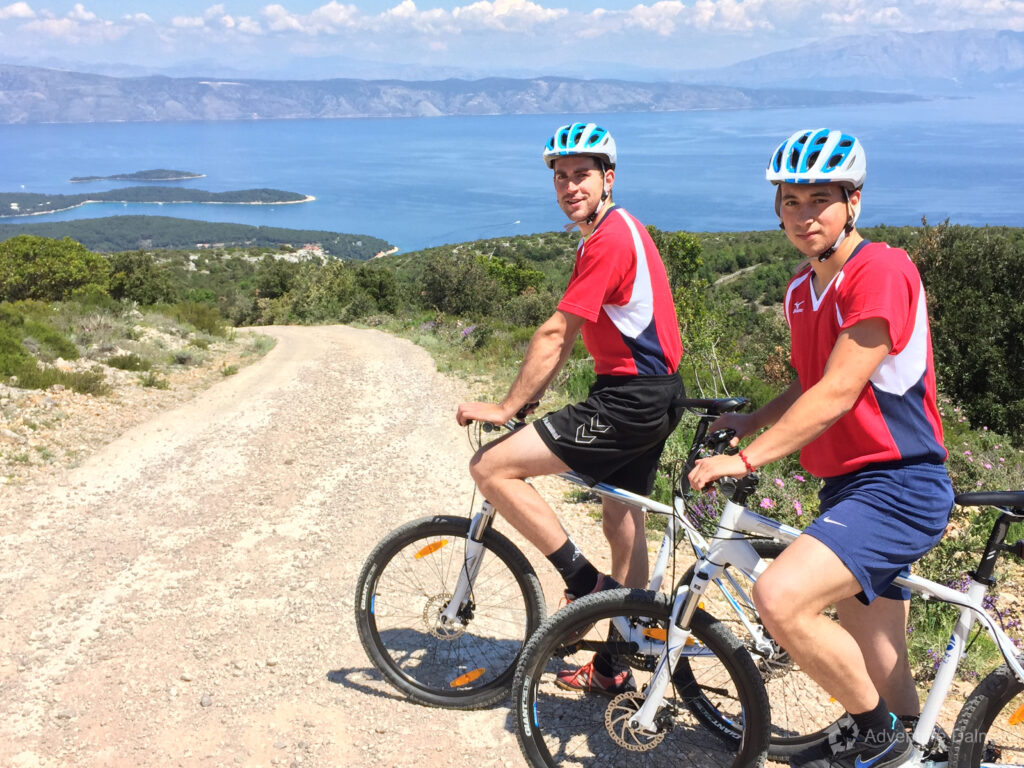
UNESCO 704 is part of the larger UNESCO Mediterranean Route, connecting cultural and natural heritage sites across Europe.
Hvar, one of Croatia’s most beloved islands, boasts a perfect blend of pristine nature and a rich historical legacy. The 704 route spans approximately 200 kilometers, meandering through picturesque villages, rolling hills, fragrant lavender fields, and sparkling beaches.
Starting in Jelsa, the route embarks along the northern coastal path towards Vrboska. Transitioning into a macadam road, the route meanders through the captivating Starigrad fields.
Upon reaching Stari Grad, the path takes a southbound direction, leading through the charming villages of Doi and Vrbanj.
Finally, the route concludes back in Jelsa, where picturesque vineyards and serene olive groves adorn the path, creating a scenic finale to the route.
Embarking on the UNESCO 704 route, cyclists are treated to the charm of Hvar’s ancient towns. Cyclists can explore the iconic Hvar Fortress, which offers panoramic views of the town and surrounding islands.
The town itself captivates with its labyrinthine streets, historic squares, and vibrant nightlife.
Continuing along the route, cyclists will encounter Stari Grad, one of the oldest towns in Europe. A UNESCO World Heritage Site, Stari Grad boasts well-preserved ancient Greek and Roman ruins, medieval churches, and a picturesque harbor. The charming town of Jelsa, known for its narrow alleys and elegant stone houses, is also a must-visit on the route.
The UNESCO 704 route immerses cyclists in Hvar’s natural splendor. As they pedal through the island’s interior, they will pass by rolling vineyards and olive groves, where they can stop to sample local wines and olive oil. The scent of lavender wafts through the air in the fields of the village of Velo Grablje, providing a serene and fragrant experience.
The route also showcases Hvar’s stunning coastline, with secluded bays, crystal-clear waters, and pristine beaches. Cyclists can take breaks to swim, snorkel, or bask in the sun at picturesque spots like Dubovica, Zarace, or the Pakleni Islands.
A journey along the UNESCO 704 route is incomplete without savoring the flavors of Hvar’s gastronomy. The island’s fertile soil and Mediterranean climate produce exceptional local produce.
Cyclists can indulge in fresh seafood delicacies like grilled fish, octopus salad, and black risotto. Hvar’s wine production is also renowned, with the indigenous Plavac Mali grape creating robust reds and refreshing whites.
To ensure a smooth cycling experience on the UNESCO 704 route, Hvar Island provides an array of services and accommodations tailored to cyclists’ needs.
Bike rentals, repair shops, and guided tours are available in Hvar Town and Stari Grad. Cyclists can choose from a range of accommodations, including hotels, guesthouses, and campsites, offering comfort and convenience.
Mljet National Park Cycling Route
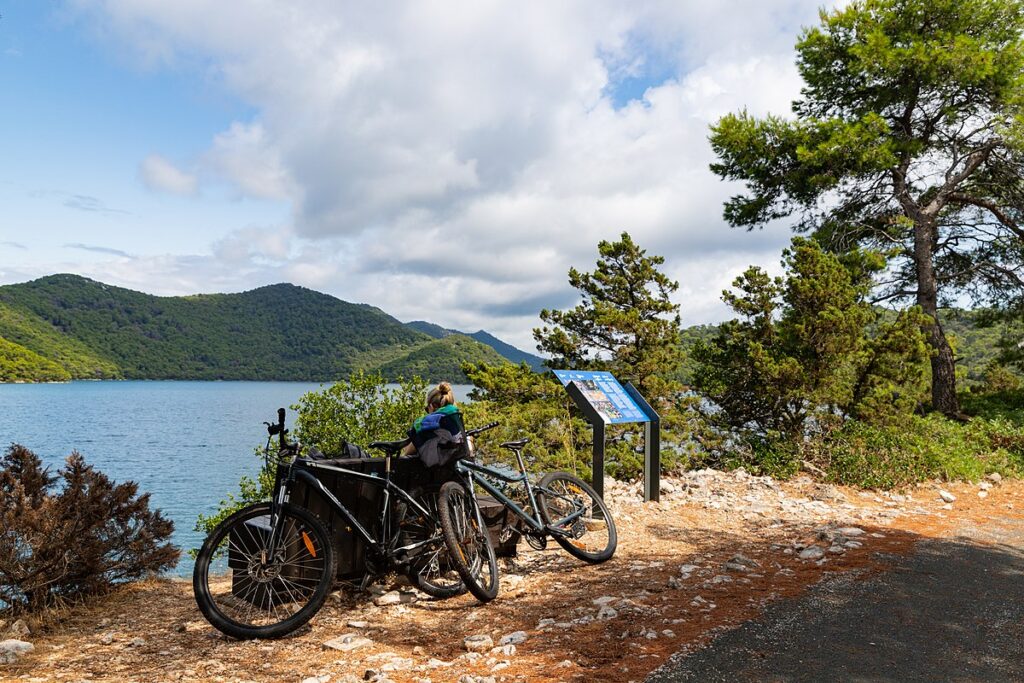
Mljet Island is renowned for its untouched nature and tranquility. With over a third of its territory designated as a national park, Mljet offers cyclists a paradise of unspoiled beauty.
The park encompasses two saltwater lakes, Veliko and Malo Jezero, connected to the sea by a narrow channel. The stunning landscapes, dense forests, and rich biodiversity make Mljet National Park an ideal destination for outdoor enthusiasts.
Mljet National Park provides several cycling routes that wind through its pristine wilderness, allowing visitors to explore the island’s diverse ecosystems.
One popular route takes cyclists around Veliko Jezero, the larger of the two lakes. This approximately 30-kilometer circuit offers breathtaking views of the shimmering lake and opportunities to stop and admire the abundant flora and fauna along the way.
For those seeking a longer and more challenging ride, a route that covers the entire island perimeter is available.
This approximately 45-kilometer journey takes cyclists through forests, vineyards, and charming villages, allowing them to soak in the natural and cultural heritage of Mljet.
Cycling through Mljet National Park provides a front-row seat to its remarkable natural wonders.
The saltwater lakes, surrounded by dense forests of Aleppo pines and Holm oaks, create a unique microclimate that sustains a rich variety of plant and animal life.
The park is home to numerous bird species, including the rare European white-tailed eagle, as well as an abundance of marine life.
As cyclists pedal through the park, they will encounter hidden coves and secluded beaches, inviting them to take a refreshing dip in the clear waters.
For a truly unforgettable experience, a visit to the tiny islet of St. Mary, located in the heart of Veliko Jezero, reveals a 12th-century Benedictine monastery that adds a touch of mystique to the natural surroundings.
Mljet Island is steeped in history and mythology, with traces of human presence dating back to ancient times. Cyclists can explore the ruins of a Roman palace in Polače, offering a glimpse into the island’s rich past.
The Odyssey Cave, a natural phenomenon named after Homer’s epic, is another intriguing site worth visiting.
Additionally, the aforementioned Benedictine monastery on St. Mary’s islet houses a museum that sheds light on Mljet’s cultural and religious heritage. Exploring these historical sites adds depth to the cycling experience, bridging the gap between nature and human history.
Cycling Croatia Inland
One of the highlights of cycling in inland Croatia is the chance to discover the country’s historic towns, each with its own story to tell.
Places like Plitvice Lakes National Park, rivers like Mura, Drava and Danube or Zagreb, the vibrant capital, showcase a mix of architectural styles, from medieval churches to Austro-Hungarian buildings, while Varaždin in the south and Osijek in the east charms visitors with its well-preserved Baroque architecture and tranquil atmosphere.
Plitvice: A Cycling Paradise in Nature’s Embrace
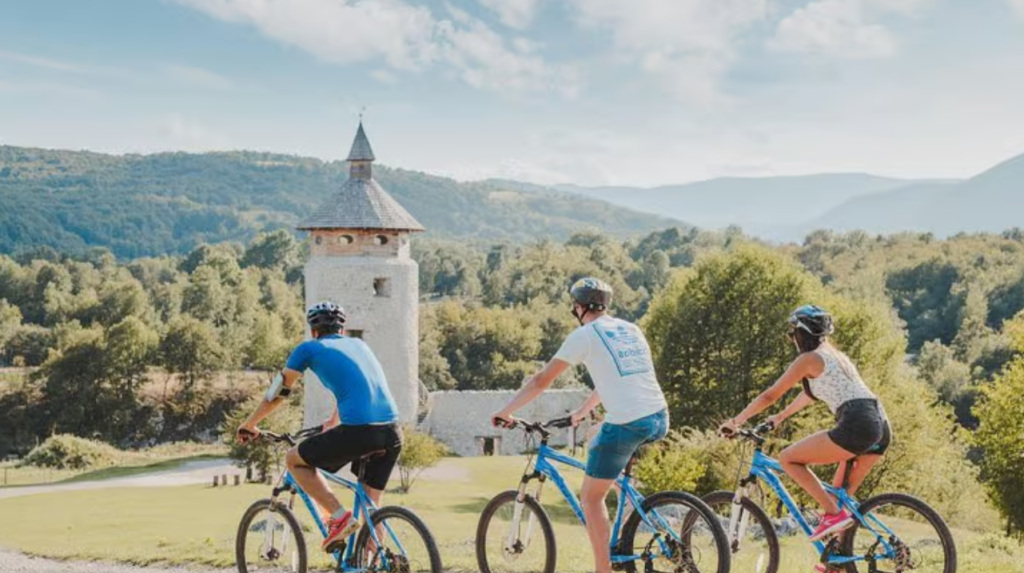
For nature enthusiasts and adventure seekers, a cycling tour near the Plitvice Lakes National Park is a must-do experience. This UNESCO World Heritage site is famous for its cascading waterfalls, turquoise lakes, and lush greenery.
The park offers well-marked cycling trails that allow you to explore its wonders on two wheels. Riding through the park’s pristine forests, along wooden walkways, and stopping at viewpoints to marvel at the breathtaking scenery is a truly immersive experience.
Discover the park’s cycling trails, winding through dense forests and offering breathtaking views of the turquoise lakes.
Take breaks to explore the park’s wooden footbridges, capture the perfect Instagram-worthy photo, or revel in the serenity of nature.
Plitvice Lakes National Park is a true gem that will leave you in awe of Croatia’s remarkable natural beauty.
The Mura-Drava Cycling Route
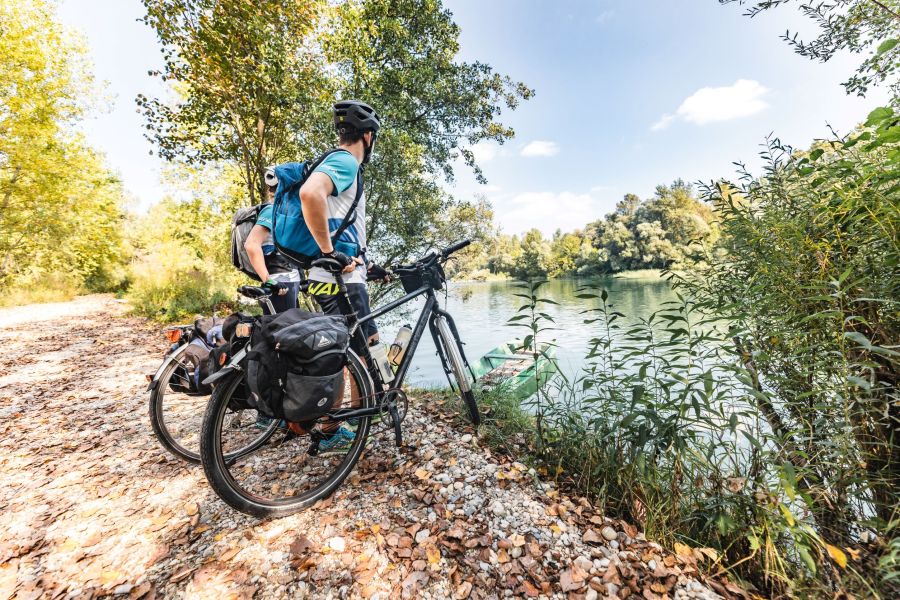
This picturesque trail, also called “The Amazon of Europe Bike Trail,” stretches across the northern and eastern parts of the country and offers an unforgettable experience for cycling enthusiasts.
The Croatian part of the Mura-Drava cycling route spans approximately 420 kilometers, winding its way through the enchanting countryside of Međimurje, Koprivnica-Križevci, Varaždin, and Osijek-Baranja counties.
The trail follows the course of two rivers, the Mura and the Drava, allowing cyclists to marvel at their tranquil beauty as they pedal through diverse terrain, including lush forests, rolling hills, and fertile plains.
One of the standout features of the Mura-Drava cycling route is its remarkable biodiversity.
The route traverses several protected areas, such as the Lonjsko Polje Nature Park and the Kopački Rit Nature Park, where cyclists can witness a rich flora and fauna.
As you pedal along, keep an eye out for elegant herons, graceful deer, and perhaps even the elusive European otter, all of which call these wetlands home.
The region’s commitment to preserving its natural heritage is evident, with the cycling route designed to minimize disruption to the ecosystems it passes through.
The Mura-Drava cycling route also offers cyclists a chance to delve into Croatia’s fascinating history and culture.
Along the way, you’ll encounter charming traditional villages, ancient castles, and archaeological sites that tell stories of the country’s past. Take a detour and visit the castles, a fairytale-like fortress perched on a hill overlooking a serene lake.
The route itself is well-maintained and clearly marked, making it suitable for cyclists of all levels of experience.
The predominantly flat terrain ensures a comfortable ride, while occasional gentle slopes and rolling hills offer a touch of variety for those seeking a bit more excitement.
Rest areas and refreshment stops are conveniently located along the route, allowing cyclists to refuel and recharge while enjoying local culinary delights.
To enhance your cycling journey, consider planning your trip during the vibrant local festivals along the Mura-Drava route.
Regarding accommodations, the Mura-Drava cycling route offers a range of options. Cyclists can choose from traditional guesthouses, cozy bed and breakfasts, or even campgrounds, depending on their preferences.
Many establishments along the route are cycle-friendly and offer amenities such as secure bicycle storage and repair services, ensuring a hassle-free experience for cyclists.
It is worth noting that the Mura-Drava cycling route is part of a larger European network of cycling paths known as EuroVelo.
This extensive network connects numerous countries and allows cyclists to embark on epic journeys, exploring Europe at their own pace.
For those with a spirit of adventure, the Mura-Drava route can be just the starting point for an even grander cycling expedition.
Pannonian Peace Trail Cycling Route
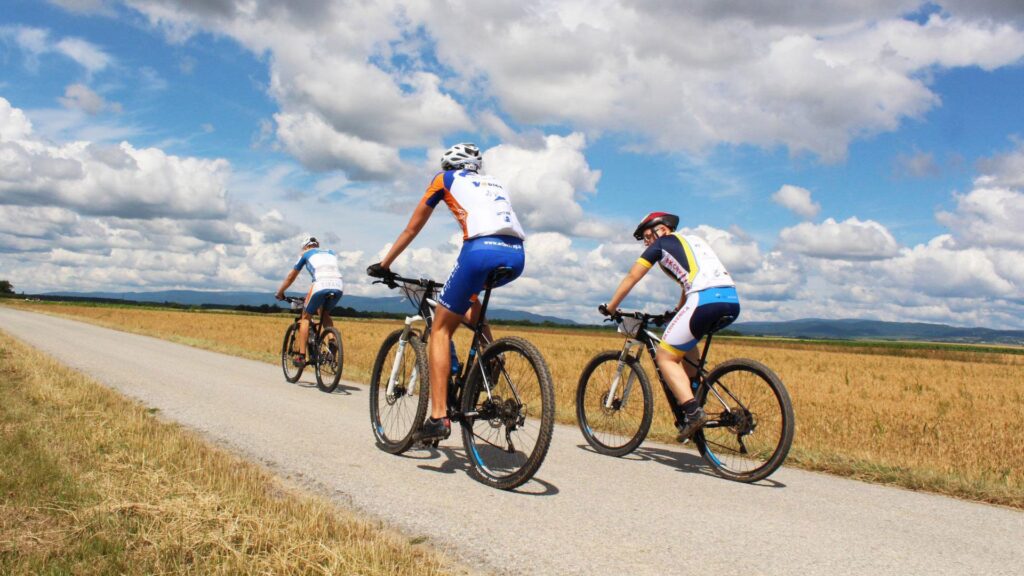
Cycling enthusiasts and nature lovers looking for an adventurous and culturally enriching experience should look no further than the Via Pacis Pannoniae Greenways, also known as the Pannonian Peace Trail.
This remarkable cycling route takes riders through the picturesque landscapes of Croatia, specifically the regions of Baranja and Slavonia, and extends into Vojvodina, Serbia.
The trail follows the majestic Danube River, connecting historical and culturally significant towns and cities, while promoting cross-border cooperation and peace-building efforts.
The Pannonian Peace Trail is part of a larger greenway network envisioned to span the Danube River and foster communication and collaboration among regions.
Two local greenway routes have already been established, with the first connecting Novi Sad to Čenej in Vojvodina, Serbia, and the second linking the cities of Osijek in Croatia and Sombor in Vojvodina.
These routes showcase the region’s natural beauty and offer a glimpse into its rich history and traditional way of life.
Traveling along the Pannonian Peace Trail, cyclists will encounter a tapestry of captivating destinations.
The route traverses several protected natural areas, including the renowned Kopacki Rit near Osijek, Croatia, and the Gornje Podunavlje Nature Reserve near Sombor, in Serbia.
These marsh reservations harbor diverse wildlife and offer a unique opportunity for nature enthusiasts to immerse themselves in the pristine beauty of the Danube River’s surroundings.
In addition to the natural wonders, the Pannonian Peace Trail also highlights numerous cultural heritage sites along the way.
The Fruska Gora National Park near Novi Sad, is one such site, with its stunning landscapes and historic monasteries. Travelers can explore traditional farms, savor local cuisine, and discover the region’s rich handicrafts.
The trail provides ample opportunities for boating, horse carriage rides, and photography, ensuring a memorable and immersive experience for visitors.
The development of the Via Pacis Pannoniae Greenways is a collaborative effort involving organizations from various parts of Europe.
The main motivation behind this visionary project was to foster connections between people, preserve the region’s natural and cultural values, and promote sustainable development in the Danube River region.
From breathtaking natural landscapes to historical and cultural treasures, this cycling route offers an immersive experience that combines adventure, history, and the spirit of peace and cooperation.
Is Croatia bicycle friendly?
Croatia is considered a bicycle-friendly destination.
Croatia has become a popular destination for cycling enthusiasts due to its dedication to promoting cycling as a sustainable and healthy mode of transportation.
The country has developed extensive cycling routes and infrastructure across its regions, making it a truly bicycle-friendly destination.
Croatia provides a vast array of cycling opportunities suitable for all levels of enthusiasts, ranging from exploring the scenic coastal regions, beautiful islands to the picturesque countryside.
The Istrian Peninsula, for instance, boasts a well-established network of cycling trails, weaving through vineyards, olive groves, and charming medieval towns.
As you cycle along the picturesque Dalmatian Coast, you have the opportunity to explore the historic cities of Split and Dubrovnik, admire the crystal-clear waters of the Adriatic Sea, and take in breathtaking panoramic views from coastal cliffs.
For the more adventurous, island-hopping cycling expeditions are also available.
Croatia has made significant investments in cycling infrastructure, such as dedicated bike lanes, signage, and accommodations, to ensure the safety and convenience of cyclists.
This, along with its stunning landscapes, makes Croatia stand out as a must-visit destination for cycling enthusiasts.
Where is the best cycling in Croatia?
While opinions may vary, Croatia’s best regions for cycling are undoubtedly Istria and Dalmatia.
Located in the country’s northwest, Istria boasts a diverse terrain that caters to both road and mountain biking enthusiasts.
The region’s picturesque hilltop towns, vineyards, and olive groves provide a scenic backdrop for leisurely rides, while more adventurous cyclists can tackle the challenging slopes of Učka Mountain or explore the rugged trails of Učka Nature Park.
Istria’s well-maintained cycling routes, such as the Parenzana Trail, a former railway line transformed into a scenic bike path, offer a unique and enjoyable way to explore the region’s rich cultural heritage and experience gastronomic delights.
The coastal areas of Dalmatia, particularly the islands of Hvar, Brač, and Korčula, also provide exceptional cycling opportunities, with picturesque coastal roads, charming villages, and stunning beaches along the way.
Whether you prefer the rolling hills of Istria or the coastal beauty of Dalmatia, Croatia offers a cycling paradise that caters to riders of all levels, making it a must-visit destination for cycling enthusiasts.
Conclusion
Croatia is a perfect place for cyclists due to its varied landscapes, cultural heritage, and breathtaking coastal views.
You can opt to cycle through the undulating hills of Istria, go island-hopping in the Dalmatian Islands, or explore the natural beauty of national parks such as Plitvice Lakes and Krka.
There’s something for every cyclist in Croatia.
Explore the hidden gems of Croatia on a bike and create unforgettable memories.
With well-maintained cycling routes, breathtaking scenery, and a welcoming atmosphere, this beautiful country is a paradise for cyclists.
You Might Also Like:
- 10 Best Croatian Wine Hotels and Winery Accommodations
- Michelin Star Restaurants in Croatia: Ultimate Guide
- Top 6 Eco-Friendly Accommodations in Croatia
- Top 12 Unique Accommodations in Croatia
- Top 8 Lesser-Known Croatian Islands
- Ultimate Guide to Croatia’s National Parks
- Best Wine Tours In Croatia
- 7 Most Unique Croatian Vineyards
- Ultimate Travel Guide to Korčula
- Top 15 Places to Visit in Croatia
- The Ultimate Croatian Food Tours and Cooking Classes




























